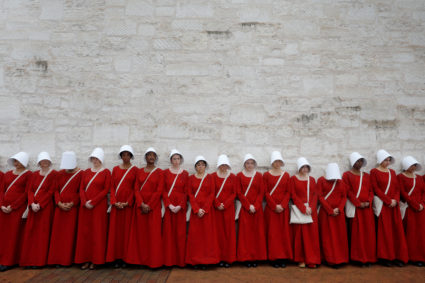
ABC will continue broadcasting the event until 2028, which will mark the 100th Oscars. This shift announced Wednesday represents a…

For more than three decades, fans of the dystopian masterpiece "The Handmaid's Tale" have gaped at the way author Margaret Atwood turned American democracy into dictatorship, in her portrayal of the fictional, theocratic society, Gilead. While the totalitarian regime in her novel doesn't resemble our current reality, the power of the book comes from the sinking feeling that Gilead could exist in the realm of possibility — should certain events occur.
Now, Atwood has made a return trip to Gilead, opening a whole new chapter, and conjuring up a new set of "what if" questions — both for her readers as much as for her characters.
Atwood has said she prefers to call her work "speculative fiction" instead of science fiction. Gilead isn't just a work of total imagination — there's precedence for that world. It may not mirror the United States in its current form, but its structure and customs do mirror aspects of 17th century New England Puritanism and dictatorships seen in different eras across the globe.
"I didn't want anybody saying, 'You're just weird,'" she told the PBS NewsHour. "Somebody asked me on Twitter recently, 'How do you come up with this shit?' My answer was, 'It's not me who has come up with it, it's the human race over the past 4,000 years.'"
Video by PBS NewsHour
In addition to history, Atwood has said she modeled "The Handmaid's Tale" after some works of dystopian literature that gripped her at a young age in the 1950s and '60s, including George Orwell's "1984," and Aldous Huxley's "Brave New World."
"Once you've been intrigued by a literary form, you always have a secret yen to write an example of it yourself," Atwood wrote in an essay for LitHub. Thus, "The Handmaid's Tale" followed.
In a recent interview with the NewsHour, the author also nodded to the work of H.G. Wells and Ursula K. Le Guin's "The Left Hand of Darkness." And finally, "in that area of dystopian totalitarianism turned into fantasy, you can't do without [J. R. R. Tolkien's] 'Lord of The Rings.'"
Additionally, Atwood shared some of the other influential dystopian fiction that helped lay the groundwork for "The Handmaid's Tale."
"I was a big consumer of sci-fi and 'spec fic' in the '50s when a lot of it was being published," Atwood said. "So it was the age of John Wyndham. It was the age of "Fahrenheit 451."
"1984" came out in 1949, which Atwood said was just "in time for it to appear as a lurid paperback with a quite sleazy cover, when I was of an impressionable age as a young teenager."
Even earlier, Atwood said she had read Orwell's "Animal Farm" "and had been horrified by it."
"I didn't understand that it was a fable about Soviet Russia," she said. "I thought it was really about those animals and was really upset by it, especially the horse. What a horrible story."
Atwood said "We," by writer Yevgeny Zamyatin, is an early Russian dystopian novel that was barred from being published in the Soviet Union in the 1920s.
"But he foresaw Big Brother and all the rest of it," Atwood said. "And the term 'liquidation,' he takes literally, so the people that they 'liquidate' actually get turned into liquid."
"Beyond the CANVAS" showcases some of the nation's leading cultural creators — musicians, playwrights, comedians, among many others — who show us how they turn their visions of the world into art. Watch the new season, starting Tuesday, March 23, on PBS or streaming on artscanvas.org.
Sustain our coverage of culture, arts and literature.